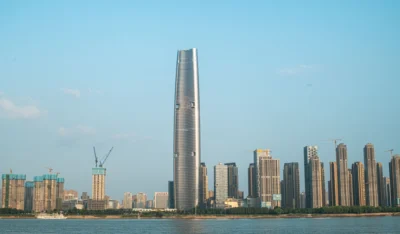A tale of two tiers in China
Soaring house prices might have led to cooling measures on the property sector, but the chill was slow to take hold in some secondary destinations

Julius Lee ponders just how much his house has appreciated in the 12 years since he bought it.
The 37-year-old electrical engineer bought his two-bedroom apartment in his home town of Dandong, bordering North Korea, for RMB320,000 (USD46,400). It is now worth about RMB600,000.
“The price has doubled so far,” said Julius.
But that is nothing compared to the sort of gains other homeowners have made since Dandong was swept up in China’s housing boom.
“My property would be considered growing slower than average [in Dandong]. For some other properties the price has increased a lot,” he said.
The unit price of his property is currently RMB5,000 per square meter. The others to which he is referring lie further west on the route to North Korea where properties fetch around RMB8,000 yuan per square meter.
Dandong, a city less travelled among foreigners, has been boosted by a thaw in diplomatic relations between North Korea and the rest of the world, and follows tireless efforts by Beijing to rev-up its economy with big real estate projects – with mixed results.
However, although Dandong’s blossoming should be a vindication of Beijing’s advances to breathe life into stagnant cities, its booming housing market reflects the headache second-tier cities have posed amid efforts to cool the industry.
Since 2016, Beijing has made a concerted effort to rein in its real estate industry amid worryingly high property prices.
On average, house prices in China have been growing nearly twice as fast as national income over the past decade, buoyed by a rising population and economic growth.
In 2016, the government decided enough was enough. Average home prices in 100 major cities in China rose 16.6 percent in September that year, compared with the year before.
The government rolled out a raft of cooling measures. One of these was to require some first-time buyers to put down a 40 percent down payment, as opposed to 35 percent. Certain second-time buyers were made to pay a minimum 70 percent, compared with 50 percent before.
Wang Menghui, minister of housing and urban-rural development, told reporters towards the end of 2017 that authorities will keep anti-speculative, city-specific measures consistent and will not loosen controls against speculation.
“The real estate market must stick to the idea that ‘homes are for people to live in, not for speculation’,” he said.
While some major cities such as Beijing and Shanghai have shown signs of a slowdown, second-tier cities have been going strong.
The dwindling hostility on the Korean peninsula prompted investors to snap up properties in Liaoning, Hunchun and Jilin provinces.
The result of this was seen in May, when China’s home prices recorded their fastest growth in nearly a year. The figures highlighted that smaller cities still rely on real estate for growth.
A CAT AND MOUSE GAME IS IN PLAY AS AUTHORITIES LOOK TO KEEP MARKETS COOL IN ONE CLUSTER OF CITIES ONLY TO FIND PEOPLE FUNNELLING THEIR MONEY ELSEWHERE WHERE REGULATIONS HAVE YET TO BE TIGHTENED
Posting a statement through its official WeChat account, Dandong Municipal Government said in May that property buyers without local household registration would not be able to resell newly-built property in the city’s New District until two years after purchase.
Yet while it may take some time before Dandong is brought under control, the measures are taking effect in other second-tier cities.
Hainan is China’s southernmost province and is popular for its subtropical climate and clean air – a treasured commodity in smoggy China. It is known as ‘China’s Hawaii’.
In March, new home prices in Haikou, the capital city of the island, rose 2.1 percent from the previous month – an increase surpassing any other Chinese city, Beijing and Shanghai included.
“The surge in Hainan’s property prices has been fuelled by market speculators. The province probably has more property investors than elsewhere,” said Yan Yuejin, director of the E-house China R&D Institute, a market intelligence firm based in Shanghai.
But following measures introduced in April, Hainan has been made to fall in line.
Chen Gaige, a real estate analyst specializing in Hainan, told Chinese media that the crackdown is having a noticeable cooling effect.
“Prior to the regulations, developers could obtain their pre-sale permit as building tops were being sealed, but now some of them have had to wait three months after construction was completed, yet still haven’t got one,” Chen said.
“Both the purchase and supply ends have been effectively controlled,” Chen said, noting many developers are also taking a wait-and-see attitude toward the local market.
In the eastern coastal city of Xiamen, Fujian Province, transactions dipped by 28.63 percent during the first half of 2018 compared to the year before. Further dips are expected in other cities where further regulation comes into effect.
At the start of August, Shenyang in northeast China’s Liaoning Province expanded restrictions on land related to commercial property purchases.
Dandong resident Julius said he has detected trepidation among investor friends who were bullish some years ago. One university friend has amassed more than 10 properties in Shenyang since he began investing in real estate in 2009.
“He saw that the price would go up. Every day he has earned a lot of money from his investments. He started investing when the prices were going up.”
“I met him before and he was very confident in 2010 but I think now he’s not quite as bullish.”
In many of the big cities measures to taper demand appear to be working but buyers are scrambling to get a bargain.
Real estate services company Jones Lang LaSalle said in a second quarter update that price caps remained in place for new launches in Shanghai and buyers continued to be actively trying to acquire units at below market prices.
In Beijing developers have been offering more competitive prices in a bid to increase sales.
“The tight policy stance is unlikely to be relaxed in the short term in China as governments aim to curb speculation and stabilize the housing market. Tight financing conditions and ongoing deleveraging exercises by some developers may see more new projects launched in a bid to ease cash flow pressures,” the report said.
Jack Xiong, the China director of Savills research and consultancy, said: “The first-hand, mass-market residential market received ample supply during [the second quarter], the majority of which was joint ownership and price-capped housing. Authorities continued to enforce strict regulations to stabilise average housing prices in the market.”
Experts predict that Hong Kong’s prices are unlikely to rise by much in the second half of 2018.
Carol Wu, head of China and Hong Kong research at DBS Bank (Hong Kong), said slower annual growth rates are likely to be the norm for the coming decade.
“Our prediction of about 5 to 10 percent price gain [in 2018] has already been reached,” said Wu.
“Hong Kong’s home price growth will decelerate, rising at no more than 2 percent a year on average through 2030, a rate similar to the inflation rate, given the growth in GDP per capita does not rise beyond expectations.”
The disparity between the patterns in property prices between big and smaller cities reflects China’s mountainous challenge in putting the brakes on an industry that has been growing wildly for so long.
A cat and mouse game is in play as authorities look to keep markets cool in one cluster of cities only to find people funnelling their money elsewhere where regulations have yet to be tightened.
This spread of money has brought prosperity to towns and cities largely forgotten and ignored, with new sources of labour. More than 20 second-tier cities hope to attract some of the growing number of educated workers leaving big cities due to the high cost of living.
For the likes of Julius, however, all this money sloshing around in property is dizzying and unpredictable. Though he has considered buying a home for investment in the past, he feels he’s better off sticking to what he knows – electrical engineering.
“There’s just too much risk in property at the moment.”
As cooling measures take hold across the Middle Kingdom it is likely he won’t be the only investor experiencing a certain degree of chill.
This article originally appeared in Issue No. 150 of PropertyGuru Property Report Magazine
Recommended
6 developments driving Asia’s green real estate shift
Developers are being incentivised to push a green agenda into daring new realms
The Philippines’ LIMA Estate drives sustainable industrial growth
LIMA Estate models a citywide vision that uplifts workers while appealing to climate-conscious employers
Malaysia property market rebounds with foreign interest and growth
The nation’s property market is stirring to life, fuelled by foreign buyers and major infrastructure drives
China’s renewable energy surge redefines housing norms and development
From exporting solar panels to building entire green-powered neighbourhoods, China’s renewable surge is redefining housing norms










